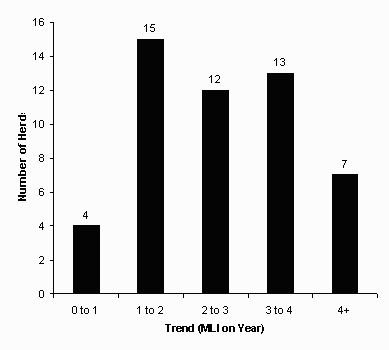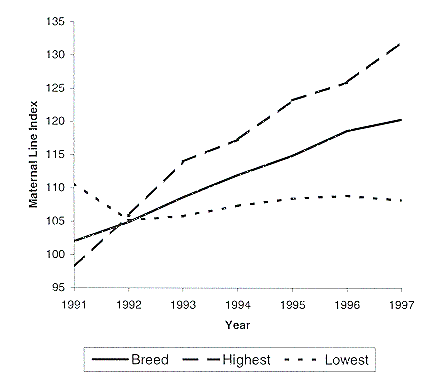
Purdue University 1998 Swine Day Report
D.L. Lofgren and A.P. Schinckel
Department of Animal Sciences
Across-herd genetic evaluations for purebred swine breeds have been available for several years. The resulting EPDs can be directly compared to each other, allowing breeders to identify the best animals in the breed. Breeders have used these EPDs when making decisions about which sows to keep in the herd, which herd boars to use for breeding, and which outside boars to purchase or use with AI. As a result, selection has produced genetic progress in individual herds and in the breed as a whole.
Genetic trend graphs and reports have been made available to breeders. The trend for the breed gives information on the breed as a whole. Within-herd genetic trend reports are also available. These give the average EPDs for all animals used in a given herd, for each year of birth. Two pieces of information in these reports are extremely useful to the breeder. The average EPD in the last year or two can be compared to the breed average, to see whether the herd is superior to the breed as a whole. The trend over time tells the breeder how much progress has been made.
This information is also useful for commercial producers. In order to find the best sources of animals, producers should look for a seedstock herd whose current average is above the average of the breed. They should also look at that herd's genetic trend; herds with good trends in the past will probably continue those trends in the future. Seedstock herds which are above average now and which are improving at an above average rate are the best sources for good quality seedstock.
The Maternal Line Index (MLI) was examined for Yorkshires. The MLI includes EPDs for both reproductive and postweaning traits. The data came from the November 1997 across-herd evaluation. The within-herd genetic trend report includes the number of pigs and averages for all EPDs and indexes for each year of birth.
To be included in this study, herds needed to have pigs with MLI for at least 5 consecutive years ending in 1996 or 1997, indicating that the herds were still testing today. Herds which were chosen had at least 100 pigs for each birth year. Three additional herds were chosen which had fewer than 100 pigs with MLI for each birth year, but which consistently had at least 30 pigs; these were considered to be "small" herds. Herds with only a few pigs per year were eliminated. There were 51 herds (48 large and 3 small) which met these criteria.
The genetic trend was calculated as the regression of MLI on year of birth. These were calculated for each herd and for the breed as a whole.
The genetic trend for the breed, from 1987 to 1997, was 2.29, meaning that the average MLI in the breed has increased 2.29 index points per year. Genetic trends for individual herds ranged from 0.09 to 5.39. The distribution of these trends is in Figure 1. The 51 trends had a mean of 2.55 and a standard deviation of 1.25. Herds have been quite varied in the amount of genetic progress which they have made. Some herds have apparently been using the EPDs quite extensively in making selection decisions, and have made dramatic genetic progress. Other herds have apparently not used EPDs in making selection decisions, as they have not made much progress in several years.
Figure 2 shows the MLI trends from 1991 to 1997 for the breed and for the herds with the highest and lowest regressions of MLI on year. Interestingly, in 1992, the two herds and the breed all had an average MLI of 105. However, they diverged sharply after that point. By 1997, the breed average was 120. The herd with the highest rate of improvement averaged 132, 12 index points above the breed. The herd with the lowest rate of improvement averaged 108, 12 index points below the breed. Indexes are economic, and a 12 point difference in MLI means $12 difference in the value of litters produced by daughters of those animals. Daughters of animals from the high herd will produce litters worth $12/litter more than daughters of animals from a breed-average herd, and $24/litter more than daughters of animals from the low herd.
Performance testing of pigs and sows is just the first step in a herd's genetic program. Genetic progress is made by using the resulting EPDs and indexes when making selection decisions. Within-herd genetic trends give important information about a herd's improvement over time, and will tell how the herd has progressed compared to the breed as a whole. They allow a breeder to determine whether his selection program has been a success. Because of the large advantage of using high indexing maternal sires versus average or below average sires, it is important that commercial producers identify the highest overall individuals - and these individuals will most commonly be obtainable from herds with the higher rates of genetic progress.

Figure 1. Distribution of genetic trends (MLI on Year) for 51 Yorkshire herds.

Figure 2. Average Maternal Line Index (MLI) for the breed, and for the herds with the highest and lowest regressions of MLI on year.
Index of 1998 Purdue Swine Day Articles
If you have trouble accessing this page because of a disability, please email anscweb@purdue.edu.